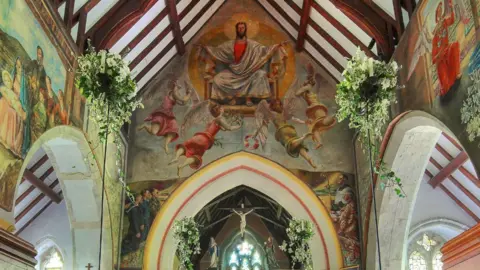One woman's fight against village over church mural
 BBC
BBCBerwick is a quaint village tucked behind the South Downs in East Sussex - but it hasn't always been as peaceful as it seems today.
In the Second World War, while the British were meant to be pulling together to beat Hitler, a much smaller war was being fought.
On 3 November 1940, the Bishop of Chichester, who had set up a scheme to decorate churches around the diocese, visited Berwick's St Michael and All Angels' Church and decided its white interior walls needed a new lease of life.
But one villager feared any artwork would attract tourists and "disturb our peace", sparking an almighty battle from the era that many are unaware ever took place.
Today, the murals lining the walls of St Michael's - by renowned Bloomsbury artists Duncan Grant, Vanessa Bell and her son Quentin Bell - are seen as a masterpiece.
But when the bishop first announced his plans for them, village resident Nancy Sandiland was furious.
"The whole thing will fall down in a year or two, no one will be able to fix it properly and damp will do the rest.
"I strongly oppose the idea," she said.
Soon, it was time for the Parochial Church Council to decide whether the plans could go ahead, and on 5 May, 1941, members cast their votes.
Eight approved the pictures. One abstained. One did not approve - Nancy.
Nancy had lived in the village since marrying Walter Alexander Sandilands in 1918, but with the marriage ending in divorce, she now lived with a friend.

With potential work on the mural now drawing closer, Nancy launched a formal opposition with an "act of petition", meaning her appeal would go to a special Consistory Church Court.
Things were getting serious in Berwick with lawyers being employed and the Lord Chancellor preparing to judge the case.
The bishop offered to visit Nancy to talk in more detail about the artist's plans, but Nancy declined saying there was "no point" as she would not change her mind.
Instead, she intensified her campaign and wrote to the bishop to clarify her position.
"Berwick Church is an ancient building of great beauty. Modern decoration would ruin its cohesion and integrity," she wrote.
She said that while the country was at war, this was not the time to be "spending money and labour on unnecessary work."
Nancy had previously promised she would not canvass the villagers to gain support for opposing to the plans, so a close friend took on the challenge on her behalf.
The court hearing had arrived and Sir Kenneth Clarke, director of the National Gallery and head of the War Artists Advisory Committee, had come to give his opinion.
Evidence was given all day and soon, Kenneth Macmorran, Queen's Counsel and Diocesan Chancellor, gave his verdict.
The murals were permitted.
Nancy was furious. In fact, after the war, she left the village entirely and moved to Lewes.
If Nancy had won her fight, the impressive murals may never have existed at all.
The pictures include the vicar, George Mitchell, along with the Bishop of Chichester and a host of others from the area.
But no Nancy, though perhaps we should not be surprised about that.
Follow BBC Sussex on Facebook, on X and on Instagram. Send your story ideas to [email protected] or WhatsApp us on 08081 002250.
